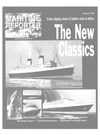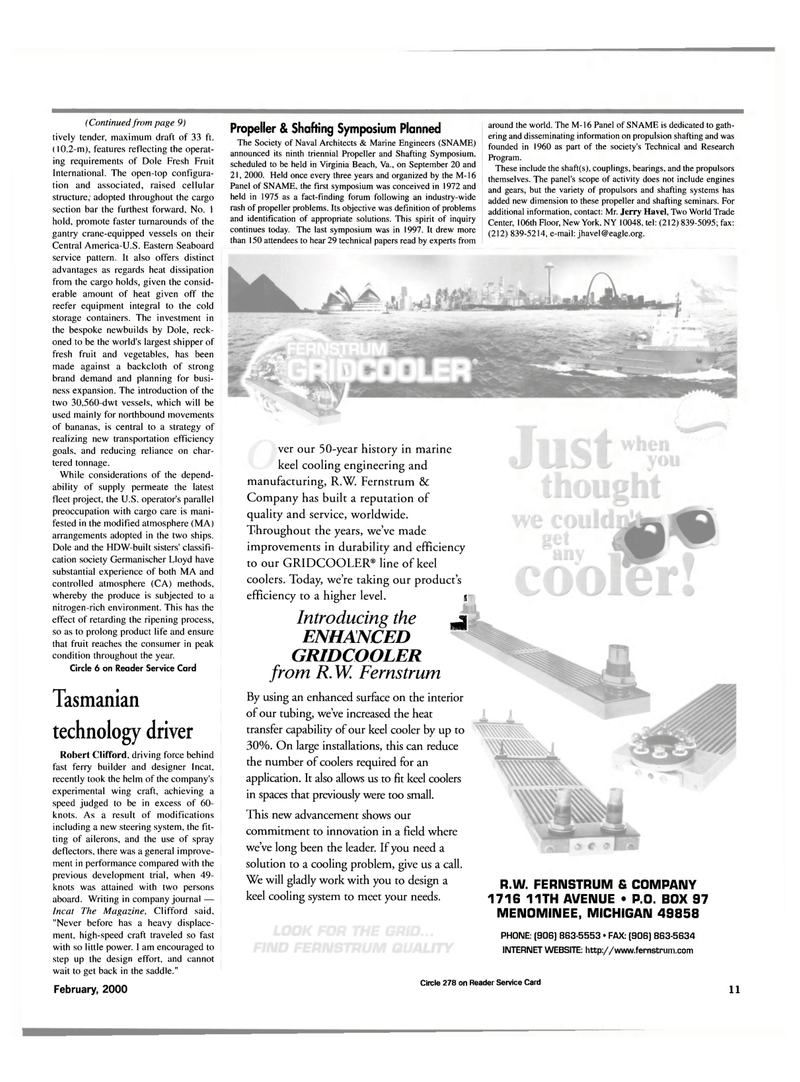
Page 11: of Maritime Reporter Magazine (February 2000)
Read this page in Pdf, Flash or Html5 edition of February 2000 Maritime Reporter Magazine
(Continued from page 9) tively tender, maximum draft of 33 ft. (10.2-m), features reflecting the operat- ing requirements of Dole Fresh Fruit
International. The open-top configura- tion and associated, raised cellular structure; adopted throughout the cargo section bar the furthest forward. No. I hold, promote faster turnarounds of the gantry crane-equipped vessels on their
Central America-U.S. Eastern Seaboard service pattern. It also offers distinct advantages as regards heat dissipation from the cargo holds, given the consid- erable amount of heat given off the reefer equipment integral to the cold storage containers. The investment in the bespoke newbuilds by Dole, reck- oned to be the world's largest shipper of fresh fruit and vegetables, has been made against a backcloth of strong brand demand and planning for busi- ness expansion. The introduction of the two 30,560-dwt vessels, which will be used mainly for northbound movements of bananas, is central to a strategy of realizing new transportation efficiency goals, and reducing reliance on char- tered tonnage.
While considerations of the depend- ability of supply permeate the latest fleet project, the U.S. operator's parallel preoccupation with cargo care is mani- fested in the modified atmosphere (MA) arrangements adopted in the two ships.
Dole and the HDW-built sisters' classifi- cation society Germanischer Lloyd have substantial experience of both MA and controlled atmosphere (CA) methods, whereby the produce is subjected to a nitrogen-rich environment. This has the effect of retarding the ripening process, so as to prolong product life and ensure that fruit reaches the consumer in peak condition throughout the year.
Circle 6 on Reader Service Card
Tasmanian technology driver
Robert Clifford, driving force behind fast ferry builder and designer Incat, recently took the helm of the company's experimental wing craft, achieving a speed judged to be in excess of 60- knots. As a result of modifications including a new steering system, the fit- ting of ailerons, and the use of spray deflectors, there was a general improve- ment in performance compared with the previous development trial, when 49- knots was attained with two persons aboard. Writing in company journal —
Incat The Magazine, Clifford said. "Never before has a heavy displace- ment, high-speed craft traveled so fast with so little power. I am encouraged to step up the design effort, and cannot wait to get back in the saddle."
February, 2000
Propeller & Shafting Symposium Planned
The Society of Naval Architects & Marine Engineers (SNAME) announced its ninth triennial Propeller and Shafting Symposium, scheduled to be held in Virginia Beach, Va., on September 20 and 21, 2000. Held once every three years and organized by the M-16
Panel of SNAME, the first symposium was conceived in 1972 and held in 1975 as a fact-finding forum following an industry-wide rash of propeller problems. Its objective was definition of problems and identification of appropriate solutions. This spirit of inquiry continues today. The last symposium was in 1997. It drew more than 150 attendees to hear 29 technical papers read by experts from around the world. The M-16 Panel of SNAME is dedicated to gath- ering and disseminating information on propulsion shafting and was founded in 1960 as part of the society's Technical and Research
Program.
These include the shaft(s), couplings, bearings, and the propulsors themselves. The panel's scope of activity does not include engines and gears, but the variety of propulsors and shafting systems has added new dimension to these propeller and shafting seminars. For additional information, contact: Mr. Jerry Havel, Two World Trade
Center, 106th Floor, New York. NY 10048, tel: (212) 839-5095; fax: (212) 839-5214, e-mail: [email protected].
PHONE: (906) 863-5553 • FAX: (906) 863-5634
INTERNET WEBSITE: http://www.fernstrum.com
Circle 278 on Reader Service Card ^ ^ ver our 50-year history in marine keel cooling engineering and manufacturing, R.W. Fernstrum &
Company has built a reputation of quality and service, worldwide.
Throughout the years, we've made improvements in durability and efficiency to our GRIDCOOLER® line of keel coolers. Today, we're taking our product's efficiency to a higher level. ?
Introducing the ^
ENHANCED
GRIDCOOLER from R. W. Fernstrum
By using an enhanced surface on the interior of our tubing, we've increased the heat transfer capability of our keel cooler by up to 30%. On large installations, this can reduce the number of coolers required for an application. It also allows us to fit keel coolers in spaces that previously were too small.
This new advancement shows our commitment to innovation in a field where we've long been the leader. If you need a solution to a cooling problem, give us a call.
We will gladly work with you to design a keel cooling system to meet your needs.
R.W. FERNSTRUM & COMPANY 1716 11TH AVENUE • P.O. BOX 97
MENOMINEE, MICHIGAN 49858

 10
10

 12
12
